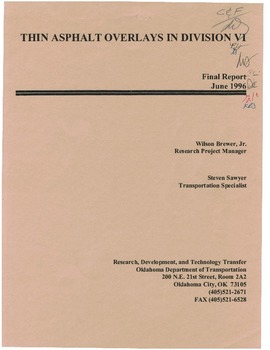| dc.creator | Brewer, Wilson B. Jr. | |
| dc.creator | Sawyer, Steven | |
| dc.date.accessioned | 2018-08-06T14:59:08Z | |
| dc.date.available | 2018-08-06T14:59:08Z | |
| dc.date.issued | 1996-10 | |
| dc.identifier.govdoc | FHWA-OK-96(11) | |
| dc.identifier.other | Oklahoma Department of Transportation State Planning and Research | |
| dc.identifier.uri | https://hdl.handle.net/11244/301367 | |
| dc.description.abstract | Field Division VI has typically applied "chip seals'' to distressed low traffic roadways. Chip seals, however, have little effect on problems such as cracking, corrugating, and rutting. One or more of these problems existed at each of the seven sites selected for the application of thin asphalt overlays in lieu of chip seals. Four similar roadway compositions were represented. Each was overlaid with 0.5 to 0.75 inches (13mm to 19mm) of Type D asphalt concrete. Field tests included traffic data collection, flexible pavement condition swveys, and rut measurements, as well a?? skid. ridemeter, and Benkelman Beam deflection tests. Construction consisted of three steps: (1) placing a tack coat or fabric membrane on the old surface, (2) laying down a thin lift of Type D asphalt. and (3) compaction. | |
| dc.format.extent | 62 pages | |
| dc.format.extent | 32,945,113 bytes | |
| dc.format.medium | application.pdf | |
| dc.language | en_US | |
| dc.relation.ispartofseries | No | |
| dc.relation.requires | Adobe Acrobat Reader | |
| dc.title | Thin asphalt overlays in Division VI (OK-96-11) 2285 | |
| dc.type | Technical Report | |
| dc.description.version | Final Report, October 1996 | |
| dc.description.peerreview | No | |
| dc.type.material | text | |
| dc.subject.keywords | Thin overlay | |
| dc.subject.keywords | Asphalt | |
| dc.subject.keywords | Chip seal | |
| dc.subject.keywords | Pavement distress | |
| dc.subject.keywords | Maintenance | |
| dc.subject.keywords | Low volume roads | |
| dc.contributor.sponsor | Oklahoma Department of Transportation. Materials and Research Division. Office of Research & Implementation | |
